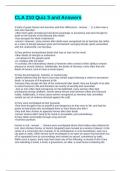CLA 210 Quiz 3 and Answers
5 traits of greek heroes and heroines and their differences - answer 1) a hero was a
man who had died
-often Demi-gods (mortals but had divine parentage or ancestors) and were thought to
dwell on the Islands of the Blessed after death
-they escaped the bleak Underworld
-women: However, some women after death were recognized not as heroines but rather
as a class of beings between gods and humankind: avenging female spirits associated
with the Underworld, not Olympus.
2) they perform extraordinary deeds that may or may not be moral
-often deeds of strength or endurance
--not always for the greater good
-ex. Oedipus kills his father
-In contrast, the extraordinary deeds of heroines often consist of their ability to endure
physical or sexual violence. Additionally, the deeds of heroines, more often than the
deeds of heroes, tend to have a moral aspect
3) they die prematurely, violently, or mysteriously
-greeks believed that the hero's soul may remain angry following a violent or premature
death, or because of ill-treatment in life
-because they escape the fate of the underworld after death, they are thought of as able
to assist humans in life and therefore are worthy of worship and veneration
-Just as men often died prematurely on the battlefield, many women often died
prematurely during childbirth. Stories about heroes and heroines reflect this historical
reality. Additionally, in many cases women recognized as heroines had committed
suicide (an act of violence directed against the self).
4) they were worshipped at their gravesite
-they were thought to be as powerful and dangerous as they were in life, and had the
power to help those who worshipped them or harm those who didn't
-they built hero shrines to appease heroes after their death
-heroes' actions didn't need to be moral or acceptable, just extraordinary
5) they obtain immortality through song and cult
-received sacrifices
heroes in cult - answer Heroes were worshipped where their bodies were believed to
rest. Hero shrines (heroa, or heroön [singular]) were located at a variety of places: in the
center of a community (for example, in its marketplace) or at its boundaries, such as a
city gate or walls. Often heroes were worshipped in an open-air space that had been cut
off or separated from its surroundings and marked as sacred, sometimes by walls.
Within such a space, there may have been any of the following: a mound of dirt of any
size indicating a burial, a tomb, a gravestone, an altar, a small house containing the
, hero's remains or offerings (also called a heroön), a small temple, or a cult statue
(Figure 10.2). The gravesites of some heroes lacked elaborate structures or burial
markers but were distinguished from other graves by the presence of dedications such
as terracotta statues, pots, jewelry, weaponry, or plaques showing males reclining on
couches and banqueting.
heroes in myth - answer -Considerable written and visual evidence about heroes
accumulated over time. Most stories and images describe only a few (sometimes just
one) of a hero's adventures.
-Rarely does any single account describe a hero from birth to death. Thus, heroes'
biographies must be culled from written and visual sources that often contradict one
another.
-vertical tradition: different versions of the same mythic episode.
-horizontal tradition: describes an account created from "different versions [that] yield a
running biography of the mythic figure."
-Most modern books of mythology favor the horizontal tradition, creating cohesive
biographies of heroes that smooth out the contradictions in multiple accounts of one
episode.
-Two literary genres (epic and tragedy) have played an especially important role in
shaping how heroes (and heroines) have been understood in antiquity as well as in
modern scholarship and arts
-Epic often emphasizes the splendor of the hero's exploits on the battlefield, in the
gymnasium, sailing the seas, or fighting in foreign lands. He is seldom depicted as a
stationary figure, content to rule a kingdom or administer a temple.
-To the epic poets, heroes are dynamic figures defined by their travels, exploits, and
actions. They are rarely glimpsed in domestic spaces. There is evidence of heroic
qualities in lyric poetry as well.
-In the Classical Period, epic heroes became the protagonists of Athenian tragedies, the
plots of which show them in cities, houses, and communities that impose varied
constraints and demands on them. The dramatic conventions of the tragic stage
necessitated that heroes' victories on battlefields and against monsters be described
(not enacted on stage), and thus these adventures become secondary to relationships
between heroes and other men, gods, and family, all of which could be depi
Heracles - answer -Heracles is the son of Zeus, although Zeus is not the reason for
the large number of myths (and cults) devoted to Heracles. Hera—or, rather, Hera's
anger at Zeus's liaison with the mortal woman Alcmene, Heracles's mother—stands
behind Heracles's greatness.
-Hera then instigates the numerous labors Heracles must perform. Driving Heracles
mad, Hera causes him to kill his wife, Megara, and their two sons. A Delphic oracle bids
him to serve Eurystheus, who then demands that he perform various deeds as a
punishment. (Some stories claim Heracles must serve Eurystheus for other crimes.)
Twelve such deeds were sculpted on the temple of Zeus in Olympia, and these have
become the canonical labors (athloi, or athlos [singular]) for which Heracles is best
known (Figure 10.5). Thereafter, all other trials and journeys of Heracles were called
side labors (parerga, or parergon [singular]).




